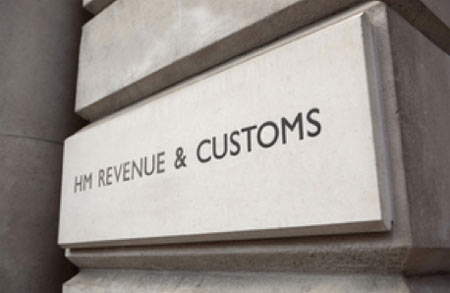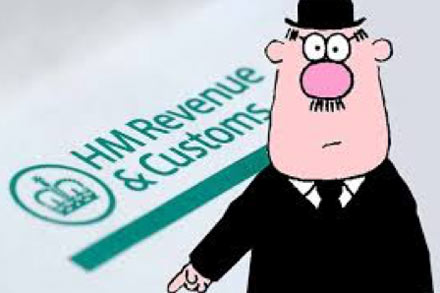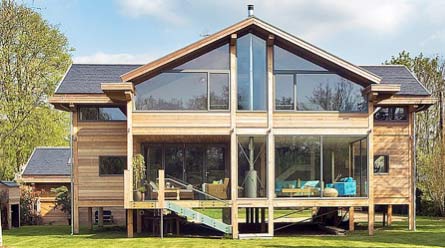Under certain circumstances it is possible to claim the Value Added Tax (VAT) back on the cost of your self-build.

HMRC – HM Revenue and Customs are responsible for collecting VAT
One of the great advantages of undertaking a new build, and one of the main reasons it is so cost efficient, is the fact that materials and labour are zero rated for VAT. You will have to pay out VAT on your materials during the build but one of the most pleasant tasks of building your own home is making a VAT repayment claim once it is complete!
How to Reclaim VAT for a Selfbuild Project
To make a claim, you will need to fill in the form 431NB with all the supporting evidence and information required to repay you the VAT that you incurred during the build. This includes:
- Invoices and bills – Often all the different items are not listed separately and as some may incur different rates of tax, you should also include further information such as tenders and estimates which support your claim. Make sure they are in your name, not someone else’s
- Credit notes if you have been given any – it is fraudulent to reclaim VAT on something that you have already been refunded
- The planning permission that you received and a full set of the plans (make sure you include all amendments if you have had them). This is to prove that the build has been authorised
- Proof that the work has been completed – there are number of acceptable forms of proof (See below)
- Your bank details – so they can pay you!
You must do this within 3 months of the building’s completion. This is usually when you receive the “certificate of completion” that will be issued by your local planning authority.
A building is generally considered as complete when it has been finished in accordance with the original plans, but if there is any doubt the completion certificate is the absolute proof.
There are a number forms of proof that the works have been completed that are accepted by HMRC:
- Your Building Control Body (BCB) will give you a completion certificate generally within 8 weeks of the all the works having been finished
- A habitation or occupation certificate
- A valuation rating or council tax assessment (Not a council tax bill)
- A letter from your bank or building society stating that they have released the last instalment of the loan against the property and they consider the work complete
There are no second chances with this process as you only get one shot at it. The importance of keeping all your paper work now comes into effect as you will need detailed information e.g. receipts etc…. The use of a spreadsheet can come in very handy in this situation.
As you only get one chance you will need to get it right first time. If you miss any receipts or other cost evidence then you will have missed out.
There is a very useful VAT Helpline if you are stuck. The number is: 0300 200 3700 (it’s generally best to call first thing in the morning as you’ll get through quicker – they open at 8am weeks days only, excluding bank holidays).

The Taxman (HMRC) will refund VAT to Self-builders
Remember that you can only use the form 431NB on a new selfbuild project. If you are converting a building into a dwelling then you should use Form 431C.
Can You Reclaim VAT on Your Selfbuild?
Yes, if your build meet the following criteria:
- It must be a new dwelling where someone – You – will live (or holiday in). This is not a business scheme so must be for you or your relatives
- It must be separate or self-contained
- It must not be a business premises, however you are allowed one room as an office
The definition of a “new dwelling” is as follows:
A New Build is a building that has been constructed from scratch and will generally not incorporate any part of an existing building
If you are constructing a new dwelling on the site of a former property, then this must have been demolished completely (leaving only cellar or basement and the slab at ground level).
If the new dwelling is going to be terraced or semi-detached then the party walls can be pre-existing (and do not need to be demolished!). Sometimes the facade might be part of the planning conditions, then this may be kept too.
If the new dwelling is an extension to an existing dwelling, then the new dwelling must be totally separate and self-contained (with no internal access).

Selfbuilding allows you to reclaim the VAT you paid on your build – Image courtesy of homebuilding.co.uk
Conversions are also eligible for the VAT refund scheme, but the building being converted must not be residential or should not have been occupied as a dwelling for at least 10 years.
Remember you will not be eligible for a VAT refund if the property cannot be sold or used separately from another property, if it is intended to be let or used for some other business purpose or the work has been carried out subsequent to purchasing it from a builder or developer.
Which Parts of Your Self-build can you Reclaim VAT?
You should not be paying out VAT on labour or Materials from your contractors (builders) so scrutinise your invoices to ensure that they are not charging you. In fact, they should charge VAT but at a zero rate.
They have a limited amount of time to correct their VAT liability with HMRC, so make sure you raise it as soon as you spot it. If they are out of time, they are very unlikely to refund you any VAT paid (since the HMRC will not refund them either).
The contractors that qualify for zero rating VAT should not charge you VAT, and they should know this, but the rules are complex and they will err on the side of caution. You can see a reference summary of the VAT rules that they should adhere to by clicking the image below if you are unsure:

VAT Notice 708: Building and Construction – Advice for charging VAT for Builders and Contractors
Garages and Outbuildings
You cannot claim for any other building other than the dwelling itself. This includes sheds, granny annexes, swimming pools, stables etc. The only exception is a garage, which you are allowed to reclaim the VAT, so long as it has been built or converted at the same time and intended for use at the same time as the dwelling that you are making the claim for.
Goods That you can Reclaim VAT From
The goods that you can claim the VAT back from are:
building materials that are incorporated into the building and can’t be removed without tools or damaging the building
With this wide definition, you can make a claim for most of the goods and materials bought from a VAT registered supplier which are incorporated into the building or the site.
As a rule of thumb, if it would damage it beyond repair to remove it then you can claim for it. However there are some notable exceptions.
You can claim for trees, plants and turf but only to the extent that they have been approved in your planning application on your landscaping scheme.
Goods That you Cannot Reclaim VAT From in a Selfbuild
These are the goods that would not be eligible for a VAT refund:
- Carpets
- Range cookers – unless designed to be part of the hot water and/or heating system
- Furniture and furnishings including curtains or blinds, mirrors and vanity cases
- Garden furniture, ornaments or sheds.
- Audio, visual and telephone systems, including CCTV, satellite boxes (you can claim for the dish), and home automation
- Free standing appliances such as cookers and white goods
- Electrical equipment for opening garage doors and gates
- Consumables such as sandpaper, masking tape and white spirit, etc
- Hire of equipment of machinery
- Professional fees, such and architects or surveyors
- Any building projects in the Channel Islands
Obviously you cannot claim for VAT that you have not paid, such as for any materials or services that have a zero VAT rating.

Organisation is the Key to Making a Successful Self-build VAT Refund Claim – Image courtesy of dailymail.co.uk
Practical Advice About how to Prepare Your VAT Refund Claim
To reitterate this point (also mentioned above), you make your claim with the Form VAT431NB on a new selfbuild project, and for any project involving conversions, you need to use Form 431C.
The form has questions about yourself and your build, mainly to confirm your eligibility. There are two sections that you need to complete listing all the invoice that you have received and are eligible for a refund:
- Part D – Details of goods for which you will be claiming back VAT (Where VAT have been shown separately on the invoice)
- Part E – Details of goods for which you will be claiming back VAT (Where VAT has not been shown and you will have to calculate it)
Remember that you can only claim for the building materials, as the (eligible) services should already have been zero rated so there will not be any VAT to reclaim. It is your responsibility to ensure you are charged the correct rate as you will not get a refund.
We have created a spread sheet for you to use to help make it easier. This can be downloaded by clicking here.

Reclaim the VAT on your self build project
Process for Compiling your VAT Refund Claim
This is the process we would recommend for getting your claim together:
- Collect and separate all your invoice into two piles:
- Invoices with VAT marked
- Invoice where the VAT is not shown
- Open the spreadsheet and enter the invoices with VAT marked into the first tab, Part D:
- Confirm that each invoice is in your name (the claimant)
- Add one invoice per line only
- Mark the only main item in the description of items field – there’s no need to mark secondary items listed on the invoice
- You can use the invoice number but we recommend you take the HMRC recommendation and use a sequential numbering system which you should add to each invoice clearly
- Make sure that you file the original invoices is the same order that you list them on the spreadsheet for submission to HMRC
- There should be a total at the end of each page, which will be continued on to the next page. The final page total is the amount that will be entered into Part F of the form – check that this is correct!
- Move the second tab (Part E) and enter the invoices where VAT is not shown. There should not be as many of these:
- Enter as before and ensure that the totals are correct.
- If you are using our spreadsheet, it is set up to calculate the VAT at the standard rate of 20%. If you have invoices with other rates you will need to list these on a separate schedule. (See below about different VAT rates)
- Confirm and print all the sheets. Add them with the invoices, plans and proof of completion to your completed 431NB form
- Check and check again!
- Submit to HMRC
Remember that it is your responsibility to check and submit the correct information, and that you only have one chance to do this. Make sure that you have included every relevant invoice and they are listed correctly.
VAT Rates Applicable to Selfbuilders
There are three different VAT rates:
- Standard Rate – currently 20%
- Reduced Rate – currently 5%
- Zero Rate – 0%
If a business is VAT registered it must charge VAT at these rates depending on the products or services that they are supplying and to whom.
The standard VAT rate does vary from time to time. It is your responsibility to ensure that you have been charged at the correct rate, which is currently 20% (from the 4th January 2011, prior to which it was 17.5%).

Claim back the VAT on the materials for your Selfbuild – Image courtesy of permaculture.co.uk
Summary of the how Self Builders can Reclaim VAT
Here are the key points for self builders reclaiming VAT:
- You can only make one claim – so include everything
- It must be made within 3 months of completion of your dwelling
- The claim can only be for a home for your use, or a relative of yours
- You can only claim for materials and not services. Make sure that if you should be charged VAT at the zero rate by your contractor that they are doing so
- You reclaim should include the following:
- Form 431NB (downloaded on the above links) on a new selfbuild project (Form 431C is for conversions, again, downloaded on the links availabel above)
- Planning Permission approvals – including amendments and plans
- Proof of completion – usually completion certificate, but other proof is possible
- Original Invoices and Bills
- You bank details – so you can be repaid
Should you have any problems you will find the HMRC really helpful:
VAT refund helpline:
- Telephone: 03000 569 145 (Monday to Friday, 9am to 4pm)
- Online: www.gov.uk/government/organisations/hm-revenue-customs/contact/vat-enquiries
Self building is probably the most challenging but certainly the most rewarding DIY Project that anyone can take on.
Make sure that you are organised and claim everything that you are due at the end of the project; this will make the project even sweeter (and help soothe some of the sore memories from when things were a little more stressful!)

